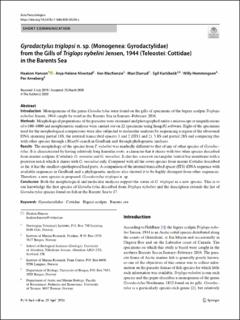Gyrodactylus triglopsi n. sp. (Monogenea: Gyrodactylidae) from the Gills of Triglops nybelini Jensen, 1944 (Teleostei: Cottidae) in the Barents Sea
Hansen, Haakon; Alvestad, Anja Helene; MacKenzie, Ken; Darrud, Mari; Karlsbakk, Egil; Hemmingsen, Willy; Arneberg, Per
Peer reviewed, Journal article
Published version

Permanent lenke
https://hdl.handle.net/11250/2728351Utgivelsesdato
2020Metadata
Vis full innførselSamlinger
- Articles [3012]
- Publikasjoner fra CRIStin [3070]
Sammendrag
Introduction
Monogeneans of the genus Gyrodactylus were found on the gills of specimens of the bigeye sculpin Triglops nybelini Jensen, 1944 caught by trawl in the Barents Sea in January–February 2016.
Methods
Morphological preparations of the parasites were examined and photographed under a microscope at magnifications of × 100–1000 and morphometric analyses were carried out on 22 specimens using ImageJ2 software. Eight of the specimens used for the morphological comparisons were also subjected to molecular analyses by sequencing a region of the ribosomal DNA spanning partial 18S, the internal transcribed spacers 1 and 2 (ITS1 and 2), 5.8S and partial 28S and comparing this with other species through a BlastN-search in GenBank and through phylogenetic analyses.
Results
The morphology of the species from T. nybelini was markedly different to that of any of other species of Gyrodactylus. It is characterized by having relatively long hamulus roots, a character that it shares with two other species described from marine sculpins (Cottidae); G. armatus and G. maculosi. It also has a narrow rectangular ventral bar membrane with a posterior notch which it shares with G. maculosi only. Compared with all the seven species from marine Cottidae described so far, it has the smallest opisthaptoral hard parts. A comparison of the internal transcribed spacer (ITS) rDNA sequence with available sequences in GenBank and a phylogenetic analyses also showed it to be highly divergent from other sequences. Therefore, a new species is proposed, Gyrodactylus triglopsi n. sp.
Conclusion
Both the morphological and molecular analyses support the status of G. triglopsi as a new species. This is to our knowledge the first species of Gyrodactylus described from Triglops nybelini and the description extends the list of Gyrodactylus species found on fish in the Barents Sea to 17.